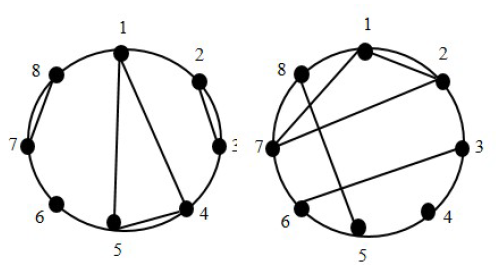The Relation of Noncrossing Partitioning of Odd and Even Numbers with Catalan Numbers
Main Article Content
Abstract
Catalan numbers, denoted by Cn, are generally defined by the equation Cn = 1/(n+1) (2n
n) with n ≥ 0 and n ∈ ℤ. Catalan numbers have forms that can be determined through general
and recursive forms. Catalan numbers have several applications to various combinatorial
problems, such as in recursive analysis and the application of combinatorial theory to
partitions that can form Catalan numbers. The odd numbers are defined as integers that are
not divisible by two, expressed in the form {2k + 1; k ∈ ℤ} . Meanwhile, even numbers are
defined as integers that are divisible by two, expressed in the form {2k; k ∈ ℤ} . In this study
we discuss the noncrossing partitions of positive odd numbers and positive even numbers.
The results show those the noncrossing partitions have relationship with Catalan numbers.
Article Details
References
[1] Igor Pak. History of catalan numbers. arXiv Preprint, 2014.
[2] Thomas Koshy. Catalan Numbers with Applications. Oxford University Press, New York, NY, 2009.
[3] Iqbal Azkamahendra and Anggun Sugandha. Bentuk umum dan rekursif bilangan catalan dari bilangan catalan modulo prima berpangkat bilangan bulat positif. Perwira Journal of Science & Engineering, 2(2):14–18 (in Indonesia), 2022.
[4] Sen-Peng Eu, Shu-Chung Liu, and Yeong-Nan Yeh. Catalan and motzkin numbers modulo 4 and 8. European Journal of Combinatorics, 28(5):1449–1466, 2007.
[5] Hsueh-Yung Lin. Odd catalan numbers modulo. Integers, 12:161–165, 2012.
[6] Tatjana Stojadinović. On catalan numbers. The Teaching of Mathematics, 18(1):16–24, 2015.
[7] Mehmed Saračević, Slađan Adamović, and Enes Biševac. Application of catalan numbers and the lattice path combinatorial problem in cryptography. Acta Polytechnica Hungarica,15(7):91–110, 2018.
[8] Kyu-Hwan Lee and Se-jin Oh. Catalan combinatorics and applications. In Contemporary Mathematics, volume 712, pages 165–185. American Mathematical Society, 2018.
[9] Mohammad Ikhan. A new conservative matrix derived by catalan numbers and its matrix domain in the spaces c and c0. Linear and Multilinear Algebra, 68(2):417–434, 2020.
[10] Khristo N. Boyadzhiev. Exotic series with bernoulli, harmonic, catalan, and stirling numbers. arXiv Preprint, 2021.
[11] Azra Selim and Mehmed Saračević. Catalan numbers and applications. International Scientific Journal Vision, 4(1):99–114, 2019.
[12] Mehmed Saračević, Mirsad Hadžić, and Enes Korićanin. Generating catalan-keys based on dynamic programming and their application in steganography. International Journal of Industrial Engineering and Management, 8(4):219, 2017.
[13] V. U. Karkarla, K. D., and C. H. Suneetha. Variable length packet cipher using catalan sequence. Journal of Theoretical and Applied Information Technology, 101(22):7394–7400, 2023.
[14] V. U. Karkarla, K. D., and C. H. Suneetha. Novel approach for encryption using catalan numbers. Intelligent Systems and Applications in Engineering, 11(4):209–214, 2023.
[15] Mehmed Saračević, Slađan Adamović, Vladimir Mišković, Nemanja Maček, and Milan Šarac. A novel approach to steganography based on the properties of catalan numbers and dyck words. Future Generation Computer Systems, 100:186–197, 2019.
[16] Sylvain Ndagijimana. On Some Properties of Catalan Numbers and Application in RNA Secondary Structure. Ph.d. thesis, University of Rwanda, 2016.
[17] Matthew Bayer and Kyle Brandt. The pill problem, lattice paths, and catalan numbers. Mathematics Magazine, 87(5):388–394, 2014.
[18] Wamiliana, A. Yuliana, and Fitriani. The relationship of multiset, stirling number, bell number, and catalan number. Science and Technology Indonesia, 8(2):330–337, 2023.
[19] Rodica Simion and Daniel Ullman. On the structure of the lattice of noncrossing partitions. Discrete Mathematics, 98:193–206, 1991.
[20] David Singmaster. An elementary evaluation of the catalan numbers. The American Mathematical Monthly, 85(5):366–368, 2018.
[21] Richard P. Stanley. Catalan Numbers. Cambridge University Press, 2015.

